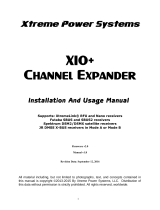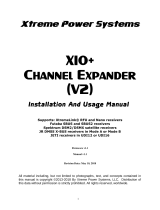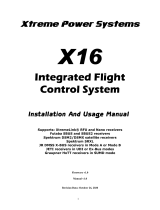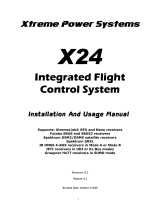Page is loading ...

Xtreme Power Systems
RFU
(RF Unit for XtremeLink
®
Radio Systems)
Installation And Usage Manual
Firmware v1.1
Manual v1.1
Revision Date: June 5
th
, 2014
All material including, but not limited to photographs, text, and concepts contained in
this manual is copyright ©2013-2014 By Xtreme Power Systems, LLC. Distribution of
this data without permission is strictly prohibited. All rights reserved, worldwide.
1

Introduction and Overview
Thank you for purchasing the RFU. This device uses a single serial data link
output that can be used with the X10+ Channel Expander or any device that
accepts Futaba SBUS protocol, Spektrum Satellite protocol, or a PPM stream.
This devices works only with XtremeLink
®
and Graupner iFS transmitter
modules and transmitters.
Installation Requirements
Connect one end of a JR female to female cable (sold separately) to the RFU
and the other end to either the X10+'s serial input, or device that you want
to control using an alternate protocol. Power to the RFU is supplied through
the cable.
Warranty Information
The RFU carries a limited lifetime warranty. Units subject to improper
installation (including reversed power), misuse, abuse, or unauthorized
modifications will not be covered under this warranty.
Xtreme Power Systems may at its discretion either repair or replace the unit
covered under warranty. The customer will pay all freight charges to and
from Xtreme Power Systems. Xtreme Power Systems must be contacted to
obtain a return authorization. Any product returned without authorization
will be returned without repair or replacement.
Liability
You understand that by using this product, you agree to hold Xtreme Power
Systems free from any type of liability either directly or indirectly while using
this product.
Legal Information
The ‘look and feel’ and functionality of this product are protected by U.S.
copyright laws. Various terminology and feature names may be protected
under U.S. trademark laws.
2

XPS acknowledges that Futaba, Spektrum, Hitec, and other names used
throughout this manual may be trademarks or registered trademarks of their
respective companies. XtremeLink
®
is a registered trademark of Xtreme
Power Systems.
3

SECTION 1 – RFU INFORMATION
Product Details
The RFU consists of a high speed computer with voltage monitoring
capabilities, a push button switch, a multi-colored LED (known as just LED
throughout this manual), a serial data stream output, and our DivBee based
RF system using true twin diversity antennas.
The push button switch has multiple functions, described throughout this
manual. The LED is a dual color type, allowing for red, green, and orange
colors.
Please note that the maximum input voltage for the RFU is 10 volts.
Exceeding this voltage will destroy the unit. You can safely use any
4 or 5 cell Nicd or Nimh pack, or a 2S Lipo pack with the RFU.
4

SECTION 2 – INSTALLATION
Powering the RFU
The RFU is powered by the single cable connection using a standard servo
type connector. The RFU operates from 1.8 volts to 10v, so it is 2S Lipo
safe. Current consumption is ~20mA unless telemetry is enabled, which
increases the current to around 70mA. When using the RFU with the X10+
Channel Expander ground, power, and signal are provided by the X10+.
When using the other devices, please consult the device's manual for
information on power availability. Polarity is critical for proper operation!
Polarity is GROUND (-), POWER (+), and SIGNAL (S) when viewing the RFU
from the backside. See Figure 1 for polarity details.
Figure 1 – RFU plug polarity details
5

Mounting the RFU
The easiest way to mount the RFU is by using the included velcro, placing it
on the backside (same side as the servo plug). Other methods such as
double-sided tape can also be used. Just make sure that mounting location
is secure so the RFU can not flop around.
Antenna Placement
The antenna leads can be flexed to fit your setup. DO NOT bend
or flex the white tip of the lead. The white portion is the actual
antenna and must remain perfectly straight for proper operation.
Placing the antennas oriented 90 degrees from each other will
yield the best reception. Always range check your installation!
DO NOT separate the two antenna leads at the RFU itself and DO
NOT remove the RFU from its case.
6

SECTION 3 – USAGE
General Information
Enable power to the RFU. When the LED is flashing red, the RFU is waiting
for a connection to your transmitter module. At this point you can put the
RFU into binding mode or into push button programming mode. If the RFU
is bound to a transmitter module then turning on your transmitter will make
the RFU connect, and the LED on the RFU will change to a solid green
(connected). The LED will always be solid green until powered off unless
there is a problem with the system.
Binding
Powered up the RFU. After the LED is flashing red, press and holding the
PROG button on the RFU until the LED turns solid green and then release the
button. The LED will now be flashing orange, indicating that the RFU is in
binding mode. Now, put your transmitter module into binding mode by
holding down the PROG button on the transmitter module and applying
power. Do not release the PROG button until the transmitter module's LED
turns green. Once you release the button, the binding procedure will occur
and the LEDs on both the RFU and transmitter module will turn green when
a successful bind has occurred. Power off the RFU and transmitter. They
are ready to be used together.
Voltage Monitoring
The RFU monitors the input voltage and will change the color of the LED
from solid green to solid orange if the input voltage drops below 4.5v.
NOTE: If the input voltage drops to 4.50v (or lower)
causing the LED to change from green to orange, then you
do in fact have a power problem with your system... no
exceptions! Do NOT ignore this warning! This device does
not lie! Many 2.4GHz systems do not tolerate low voltage
conditions well, resulting in brown outs and reboots.
Please resolve any voltage issues you might have before
attempting to operate your radio controlled device!
7

Reboot Warning
The RFU will flash the LED orange if the power is lost while connected to the
transmitter. You can deliberately cause this problem if you swap batteries
powering your system without turning off the transmitter.
Failsafe Configuration
The RFU can control the failsafe when there is a loss of signal. This is just
like any other XtremeLink
®
receiver. If you are using the RFU with the
X10+, we recommend that you do NOT use the RFU for controlling
the failsafe settings or any other setting (such as channel mapping).
The X10+ has much more control over the servo system. The
following information is being supplied for those using the RFU with
a different output protocol (non-X10+ use) and need failsafe and
channel mapping capabilities.
The default mode for all channels is USER DEFINED. However, until the
positions are actually defined (using our exclusive Live Active Failsafe),
servos will HOLD their last position when a failsafe occurs. The Live Active
Failsafe allows you to set the positions of the servos while the transmitter
and receiver are connected, allowing you to physically see and move the
surfaces to positions you want them to be at should a failsafe occur.
To set the failsafe positions (Live Active Failsafe), make sure that you can
move the servos with your transmitter and then press and hold the PROG
button on the RFU until the LED turns off and then starts flashing alternately
red and green, and then release the button. The LED will continue to
alternately flash red and green for approximately 7 seconds. During this
time, use your transmitter to move the servos to where you want them to be
when during a failsafe condition. When the LED stops flashing and returns
back to solid green, the positions are locked into memory and the failsafe
positions are permanently stored. Only repeating this procedure or
performing a factory reset will change the failsafe position settings.
XDP Programming Mode
The RFU can be wirelessly programmed with the XDP (XtremeLink
®
Device
Programmer) just like any other XtremeLink
®
receiver. To put the RFU into
XDP programming mode, press and HOLD the PROG button and then apply
power to the RFU until the LED turns solid orange, and then release the
button. The RFU is ready for XDP programming.
8

Factory Reset
The RFU's various settings can be reset to the factory defaults. This is
handy when you have made a lot of changes and want to start over or when
moving the RFU to a new model. To cause a factory reset, press and HOLD
the PROG button and then apply power to the RFU. The LED will turn solid
orange, but do not release the PROG button until the LED starts flashing red.
Once the LED is done flashing red, remove the power. The reset has been
performed.
Output Modes
The RFU can output numerous protocols over its data port. Besides the
“Xtreme” protocol used with our X10+, the RFU can also emulate a Futaba
S.BUS receiver output, Spektrum satellite receiver (low and high resolution
modes) output, and a composite PPM data stream. If you have a device
such as a 3 axis gyro, flight stabilization system, etc. check with the owners
manual to determine what protocols it can accept. It is common to have
both Futaba S.BUS and Spektrum protocols supported.
9

SECTION 4 – PROGRAMMING OPTIONS
There are 5 programming options available. To enter programming mode,
apply power to the RFU and wait for the LED to start flashing red. Now,
press and hold the PROG button until the LED turns off, and then turns solid
red. The RFU is now in push button programming mode.
Briefly pressing and releasing the push button will change the color of the
LED. The color of the LED and its associated function are listed below:
LED COLOR PROGRAMMING MODE
Red 1 - Set Output Mode
Green 2 - Set Channel Map
Orange 3 - Set Failsafe Map
Blinking Red 4 - Set Failsafe Timeout
Blinking Green 5 - Set Telemetry Mode
Press and release the PROG button until you have selected the function you
want to change.
FUNCTION 1 – SET OUTPUT MODE
Range: 1 to 5 (Default: 1)
The RFU needs to know what type of serial data it is suppose to be
outputting. With the LED solid red (programming mode 1), press and hold
the PROG button for ~2 seconds (until the LED turns OFF), and then
immediately release the PROG button. The LED will now flash green the
number of times equal to the current Input Mode (for example, 5 flashes is
equal to Futaba S.BUS Output Mode).
After the green flashing stops you have five seconds to change the Output
Mode. Press and release the programming button the number of times
equal to the new Output Mode you want. With every press and release of
the PROG button, the LED will turn red so you can visually see when the
button press is detected.
10

If you do not press the PROG button within five seconds, or if the value you
enter exceeds what is allowed, the LED will alternately flash red and green
(error condition occurred) and no change will be made.
If you do make a change, the LED will blink green/red/orange in rapid
succession to let you know that the change was successful.
The table below shows the possible serial inputs that the RFU understands
and can use.
SERIAL OUTPUT MODE DATA TYPE
1 FLASH Xtreme (Fast)
2 FLASHES Xtreme (Slow)
3 FLASHES Spektrum (11 bit)
4 FLASHES Spektrum (10 bit)
5 FLASHES Futaba S.BUS
6 FLASHES PPM (negative shift)
7 FLASHES PPM (positive shift)
Xtreme Fast is 250KBps and Xtreme Slow is 125KBps. Currently, only the
X10+ and OpenAero2 support the Xtreme Fast mode.
The Spektrum 11 bit mode is the 2048 resolution mode, whereas the
Spektrum 10 bit mode is the 1024 resolution mode.
The Futaba S.BUS is not the same as S.BUS2. S.BUS2 is a bi-directional
communication port, which is currently not supported.
The PPM outputs are used for flight simulators, and devices that accept
“composite PPM”. Please note that the number of channels is capped at 8
for either PPM mode.
11

FUNCTION 2 - SET CHANNEL MAP
Range: 1 to 16
Channel mapping is a handy feature when you have a transmitter with
limited functionality, you just want assign channels to different output pins
to make wire routing neater, or if you need to duplicate channels. The
default channel map is 1:1. This means that the transmitter channel 1 will
appear as the first output in the data stream and will be controlling the servo
assigned to the transmitter’s channel 1 function. If you are using the RFU
with the X10+ it is recommended that you do all of the channel mapping
with the X10+ itself and not the RFU. If you are using the RFU with a flight
stabilization system, the channel mapping can help you with switching
channels when the channel number is different than the device excepts. For
example, JR and other transmitters output channels 1, 2, 3, and 4 as
throttle, ailerons, elevator, and rudder... but Futaba transmitters output
these as ailerons, elevator, throttle, and rudder. Having the channel
mapping feature would let you use a Futaba transmitter with a XtremeLink
®
transmitter module to control a composite PPM device with the correct
channel order.
With the LED solid green (programming mode 2), press and hold the PROG
button for ~2 seconds (until the LED turns OFF), and then immediately
release the PROG button. This enters channel mapping mode.
The LED will now flash orange the number of times equal to the current
channel map position, followed by a one second pause. Every time you
press and release the programming button, the channel map position will
advance by one. The channel map position begins at 1 (one flash) and ends
with 16 (sixteen flashes).
To change the channel number associated with the currently selected
channel map, press and hold the programming button until the LED turns off
and begins flashing green. The LED will flash green the number of times
equal to the currently assigned transmitter channel. For example, the
default value for channel 1 is 1, so there would be just one green flash. If
there were 3 green flashes for channel 1, it would mean that channel 1 has
been mapped to the transmitter's channel 3. After the LED is done flashing
green, you have five seconds to enter a new channel number value. You do
this by pressing and releasing the programming button the number of times
equal to the channel number you want that channel to be.
12

If you do not press the programming button within five seconds, or if the
value you enter exceeds what is allowed, the LED will alternately flash red
and green (error condition occurred) and no change will be made. At this
point, you are back at the channel map position selection (LED flashing
orange the current Output Port) and you can try changing the channel
number again, or advance to the next Output Port. There is no way to get
back to the programming mode start with this feature other than by
powering off the RFU and re-entering the programming mode again.
If you do make a change, the LED will blink green/red/orange in rapid
succession to let you know that the change was successful.
FUNCTION 3 - SET FAILSAFE MAP
Range: 1 to 16
It is possible to set the failsafe control for each channel individually. In the
event of a failsafe you can set each channel to either HOLD last position, go
to a USER DEFINED position, or turn OFF the channel output completely.
NOTE - The default for ALL outputs is USED DEFINED position.
With the LED solid orange (programming mode 3), press and hold the PROG
button for ~2 seconds (until the LED turns OFF), and then immediately
release the PROG button. This enters failsafe mapping mode.
The LED will now flash orange the number of times equal to the current
channel number, followed by a one second pause. Every time you press and
release the programming button, the channel number will advance by one.
The failsafe map position begins at channel 1 (one flash) and ends with 16
(sixteen flashes).
To change the failsafe control for that channel number, press and hold the
programming button until the LED turns off and begins to flash green. The
LED will flash either one time (HOLD), two times (USER DEFINED), or three
times (OFF). After the LED is done flashing green, you have five seconds to
enter a new failsafe control value. You do this by pressing and releasing the
programming button either one time for hold last position, two times for
user defined position, or three times for channel off.
13

If you do not press the programming button within five seconds, or if the
value you enter exceeds what is allowed, the LED will alternately flash red
and green (error condition occurred) and no change will be made. At this
point, you are back at the failsafe map position where you can advance to
the next channel. There is no way to get back to the programming mode
start with this feature other than by powering off the RFU and re-entering
the programming mode.
If you do make a change, the LED will blink green/red/orange in rapid
succession to let you know that the change was successful.
FUNCTION 4 - SET FAILSAFE TIMEOUT
Range: 1 to 5 seconds (Default: 2)
A failsafe condition occurs when either no data or invalid data is received by
the RFU for some period of time. This time can be set from one to five
seconds.
With the LED blinking red (programming mode 4), press and hold the
programming button until the LED turns off. The LED will now flash green
the number of times equal to the current failsafe time (in seconds). For
example, if the failsafe time is set to two the LED will flash two times,
indicating a failsafe period of two seconds.
After the flashing stops you have five seconds to change the failsafe time.
To change the failsafe time, press and release the programming button one
time for each second you would like the failsafe time to be. For example, if
you wanted the failsafe time to be 1 second, you would press and release
the programming button once. If you wanted the failsafe time to be 3
seconds, you would press and release the button 3 times.
If you do not press the programming button within 5 seconds, or if the value
you enter exceeds what is allowed, the LED will alternately flash red and
green (error condition occurred) and no change will be made. At this point,
you are back at the programming mode start.
If you do make a change, the LED will blink green/red/orange in rapid
succession to let you know that the change was successful.
14

FUNCTION 5 - SET TELEMETRY MODE
Range: 1 to 3 (Default: 3)
The RFU can transmit telemetry information to the Telemetry Station or
XtremeLink telemetry capable transmitter. There are 3 options available.
The table below shows the possible telemetry output modes.
SETTING MODE
1 FLASH PC telemetry
2 FLASHES PC & Tx telemetry
3 FLASHES Telemetry OFF
With the LED blinking green (programming mode 5), press and hold the
programming button until the LED turns off. The LED will now flash green
the number of times equal to the current telemetry mode. For example, if
the telemetry mode is set to OFF, the LED will flash three times.
After the green flashing stops you have five seconds to change the
Telemetry Mode. Press and release the programming button the number of
times equal to the new Telemetry Mode you want. With every press and
release of the PROG button, the LED will turn red so you can visually see
when the button press is detected.
If you do not press the programming button within 5 seconds, or if the value
you enter exceeds what is allowed, the LED will alternately flash red and
green (error condition occurred) and no change will be made. At this point,
you are back at the programming mode start.
15
/








